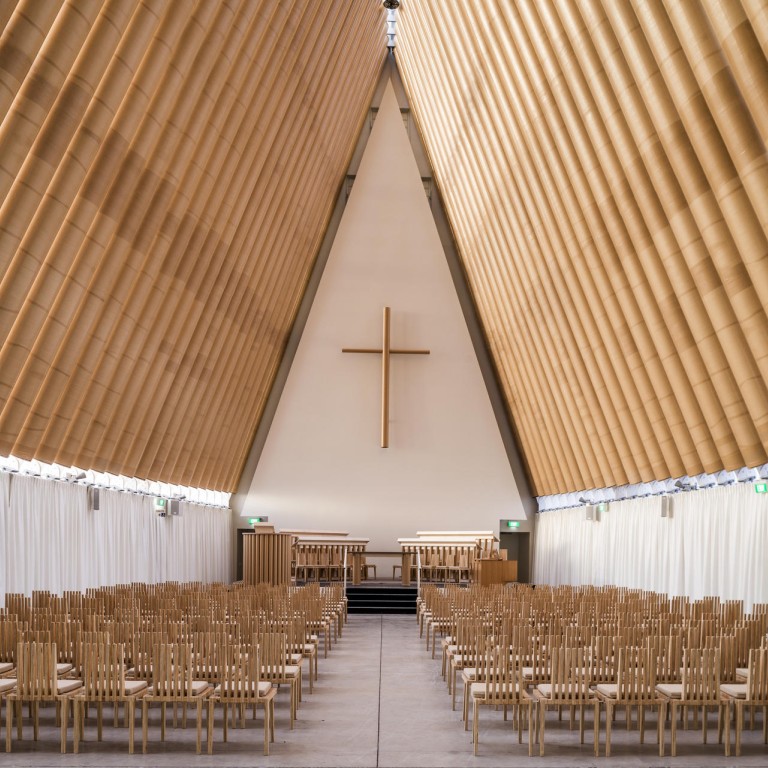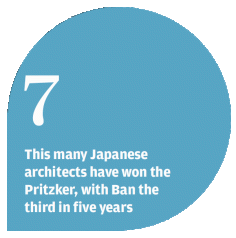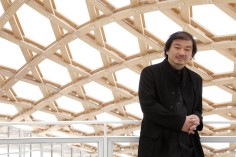
Pritzker Prize for Japanese architect Shigeru Ban, who builds in cardboard
Japan's Shigeru Ban wins the Pritzker Prize for innovative designs that use everyday materials in humanitarian efforts around the globe
The Japanese architect Shigeru Ban, who has combined a talent for innovative design and experimental use of everyday materials with extensive humanitarian efforts around the globe, has won the 2014 Pritzker Architecture Prize.

"I haven't achieved that level yet," Ban said from Copenhagen after winning the 2014 Pritzker Architecture Prize.
Ban, 56, is the seventh architect from Japan to receive the honour. For two decades he has rushed to the site of disasters - for example the 1995 earthquake in Kobe, Japan, or the 1994 conflict in Rwanda - to construct temporary shelters. He has used cardboard paper tubes as building materials, since they are easily found, easily transported and can be water-proofed or fire-proofed.
Ban's relief work has not been limited to creating living shelters. In the wake of the 2009 earthquake in L'Aquila, Italy, for example, he created a temporary auditorium so the city's musicians could continue to play. And after the 2011 earthquake and tsunami in Japan, he created partitions for existing emergency shelters so families could have privacy.
Outside his humanitarian work, Ban's noted projects have included the Centre Pompidou-Metz, a modern art museum in Metz, France, that features a remarkable curved roof made of timber - and inspired by a Chinese hat.
In its citation, the Pritzker jury noted Ban's unique approach to materials. "He is able to see in standard components and common materials, such as paper tubes, packing materials or shipping containers, opportunities to use them in new ways," the jury said.
It noted his "Naked House" in Saitama, Japan, in which the architect used clear corrugated plastic on the external walls and white acrylic stretched across a timber frame to create a home that questions "the traditional notion of rooms and consequently domestic life".
Ban's "Curtain Wall House" in Tokyo uses two-storey-high white curtains to open or close the home to the outside. Similarly, his "Metal Shutter Houses" in New York's Chelsea neighbourhood feature a unique metal shutter system to open up apartments to the city air.
But it is Ban's humanitarian work that the Pritzker jury emphasised in announcing the prize, which will be formally awarded on June 13 at the Rijksmuseum in Amsterdam. "Where others may see insurmountable challenges, Ban sees a call to action," the citation said.
Speaking this week in one of the distinctive "Metal Shutter House" apartments, Ban, who has offices in Tokyo, Paris and New York, said that despite his extensive work for private clients, his humanitarian efforts were of utmost importance.
Architects, Ban noted, are lucky because they always work for people who are happy - as people generally are when they're building a house. But he's always felt that architects need to play a broader social role.

In times of disaster, building materials can be difficult and expensive to procure. That's why, Ban said, his favourite building material is something most people throw out: cardboard tubes.
"Even in Kigali, Rwanda, when I was building shelters, I found them," he said. "I'm not inventing anything new, just using existing material differently."
After the Kobe earthquake of 1995, he built a "Paper Church" that remained there for 10 years, he said, because of affection for it. Ultimately it was dismantled to make way for a permanent structure and rebuilt in Taiwan as a community centre.
Average US home size rises
Is America's love affair with big houses finally over?
Yes and no. Last year, fewer big houses were built, but the average size of new homes continued to increase.
According to the latest US census data, the percentage of new houses built last year with more than 3,000 square feet of living space dropped to 31 per cent from a high of 45 per cent at the peak of the home-building boom in 2007. At the same time, the average size for a new home edged towards the 3,000-square-foot benchmark, ballooning to 2,679 square feet, 160 more than the previous year. The average house size is also bigger, by 180 square feet, than the average built during 2007's housing peak, when it was 2,499 square feet.
The appeal of ever-larger "average-sized" houses can be explained in large part by the changing pool of new-home buyers, observers say. Last year, the number of first-time buyers purchasing smaller houses fell because of this cohort's difficulty in obtaining financing. With a challenging job market and stricter lending requirements, far fewer of them qualified for mortgages.
With proportionately more affluent home buyers in the mix, new homes typically had more upscale features. Nearly half had four bedrooms (48 per cent), a third full bath was a popular option (35 per cent) and a three-car garage (22 per cent).
